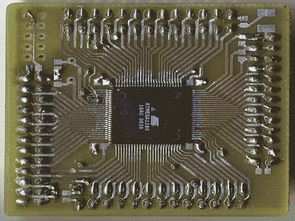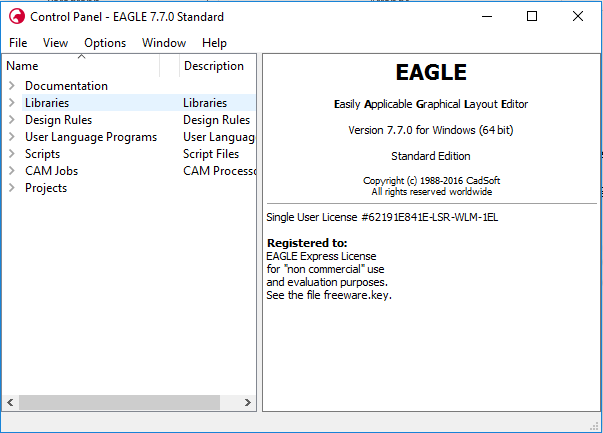Quick guide on exporting PCB designs from Eagle and importing theminto FlatCAM. This guide was made with Eagle version 7.2.0 Light andFlatCAM 8.2.
Most designs start with schematics of your circuit:

Open .pcb File In Eagle
- Resulting PCB projects, with opened schematic and PCB documents after importing EAGLE.pcb and.sch design files. Post-Import Considerations. After importing your EAGLE design files, it is fairly common to check and possibly change a few things. The following is an example of a post-import procedure that may be undertaken.
- First of all, you will need to open your PCB design file in Eagle. This file will have a.brd extension. After that, following the following instructions: 1.Select “File - CAM Processor”.
Then by clicking on File→Switch to board, the board editoris opened and you can complete your layout:
To export Gerbers, go to File→CAM Processor in the board editor,and choose the settings shown in the figure below. Include the copperlayer that you want to export and the Pads and Vias layers. Choosea proper name for your output file and click Process Job. Repeatfor each desired layer.
For drill files, go to File→CAM Processor again and select the settingsin the figure below. Do not provide an extension to the drill file name.Click on Process Job to export.
Eagle Schematic/PCB/libs can be imported, but EasyEDA can only support version 6 and later (6+) because that was when Version 6 Eagle adopted an ASCII XML data structure as their native file format. If your Eagle file can be open in Eagle, but can’t be imported in EasyEDA, you can save as a copy with the latest Eagle, and then import it.

We are done with Eagle. Now let’s move on to FlatCAM.
Eagle uses Trailing Zeros in its Excellon number format but does notproperly report this format in the Excellon file. To tell FlatCAM touse this format by default set this system option excellon_zeros to Tby using the set_sys command in the Shell Command Line Interface as shown below:

The command get_sysexcellon_zeros is optional and only lets yousee what the excellon_zeros option was set to originally.
Note
Eagle Pcb Viewer
Changes to system options are persistent. They will remainset to the given value when you restart.
This completes all the adjustments. Now simply open the Gerbers and Excellonfiles that you exported from Eagle.
What is Eagle software?
EAGLE is a scriptable electronic design automation (EDA) application with schematic capture, printed circuit board (PCB) layout, auto-router and computer-aided manufacturing (CAM) features. EAGLE stands for Easily Applicable Graphical Layout Editor (German: Einfach Anzuwendender Grafischer Layout-Editor) and is developed by CadSoft Computer GmbH. The company was acquired by Autodesk Inc. in 2016.EAGLE contains a schematic editor, for designing circuit diagrams. Schematics are stored in files with .SCH extension, parts are defined in device libraries with .LBR extension. Parts can be placed on many sheets and connected together through ports.
The PCB layout editor stores board files with the extension .BRD. It allows back-annotation to the schematic and auto-routing to automatically connect traces based on the connections defined in the schematic.
When you finished your PCB design in Eagle, you could generate Gerber files which is needed by PCB manufacturer. This NextPCB’s article is telling you how to export the Gerber file from Eagle software.

Step 1.Open the CAM Processor
Open your PCB layout (.brd) file in Eagle, Click the “ CAM” button or choose “File -> CAM Processor”.This will open the CAM Processor tool that is used to generate the files.Step 2.Click File -> Open -> Job
Step 3.Then navigate to your default EAGLE cam folder, choose the GERBER_RS274x.cam file, press Open.
Step 4.Adding a second silk screen (Optional)
If you look at the Layer options, it doesn’t have a file for silk screen bottom.But if you need silk screen on bottom layer as well, follow these steps:a. Click “Add”
b. Change Section to something like “Silk Screen SOL”
c. Change File to “%N.pls”
d. Deselect all layers
e. Select layers 20 “Dimension”, 22 “bPlace” and 26 “bNames”
Step 5.Select the Process Job button to create all of your Gerber files.You can find all of your generated Gerber files in the Autodesk EAGLEControl Panel in your project folder.
Step 6.Generating Your Drill File
a. Select the CAM Processor at the top of your interface orselect File » CAM Processor to open the CAM processor dialog.
b. You now need to load a drill CAM job to get things started. Select File » Open » Job,
and in your default EAGLE cam folder select the excellon.cam file, then select Open.
c. you'll now have a single Generate drill data tab available, which will grab the data from layers 44 Drills and
45 Holes, just what you need. Select the Process Job button to generate this file.
After those step, Gerber files and Drill data have been exported from Eagle software.
Feel free to contact us: support@nextpcb.com
if you have any more questions.